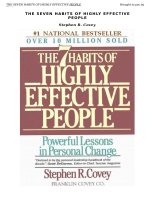Chapter 16a using effective promotions
Bạn đang xem bản rút gọn của tài liệu. Xem và tải ngay bản đầy đủ của tài liệu tại đây (604.4 KB, 37 trang )
Chapter 16
Using
Effective
Promotions
McGraw-Hill/Irwin
Copyright © 2013 by The McGraw-Hill Companies, Inc. All rights reserved.
PROMOTION
in an ORGANIZATION
• Promotion Mix -- The combination of promotional
tools an organization uses. The traditional mix
includes:
16-2
ADVERTISING
16-3
ADVERTISING in the FIRM
• Advertising -- Paid, nonpersonal communication
through various media by
organizations and individuals
who are in some way
indentified in the message.
• Major goals of advertising:
- Inform
- Persuade
- Remind
16-4
IMPACT of ADVERTISING
• Total advertising expenditures
exceed $241 billion yearly.
• Consumers benefit because
production costs of TV
programs, radio programs,
newspapers and magazines
are paid for by advertisers.
• Marketers choose ad media
that will reach the target
market.
16-5
SOCIAL ADVERTISING
• Social media advertising
is growing so fast,
marketers can’t keep up.
• Starbucks has over 12
million followers on
Twitter.
• McDonald’s has over 7
million fans on Facebook.
16-6
MATCH GAME
Match the Company with the Slogan
• “Everybody doesn’t like something, but nobody
doesn’t like ___________.”
• “It takes a licking and keeps on ticking.”
• “With a name like _________, it has to be good.”
• “Good to the last drop.”
• “Betcha can’t eat just one!”
16-7
POPULAR ADVERTISING MEDIA
• TV advertising is still the dominant media.
• Digital Video Recorders (DVRs) challenge TV
advertising because viewers can skip ads.
• Product Placement -Advertisers pay to put
their products into TV
shows and movies where
the audience will see
them.
16-8
INFOMERCIALS and
ONLINE ADVERTISING
• Infomercial -- A full length TV program devoted
exclusively to promote a particular product.
• Online Ads are attempts to get potential customers
to a web site to learn about a product.
16-9
INFOMERCIAL HALL of FAME
The Biggest Hits Over the Past 40 Years
• Veg-O-Matic
• Ginsu Knives
• The Clapper
• Thigh Master
• George Foreman Grill
• Bowflex
Source: Fortune, www.fortune.com, accessed July 2011.
16-10
MONITORING
AD EFFECTIVENESS
• Dr. Pepper posts messages
on Facebook and monitors
the results from their over
8.5 million fans.
• Richard Branson tweets his
customer base to maintain
two-way communication.
Photo Courtesy of: Brent Moore
16-11
ADVERTISING GLOBALLY
16-12
ADVERTISING EXPENDITURE by
MEDIA in $ MILLIONS
Projected 2013
Spending
Rank
Media
1
Direct Mail
$52.3
2
Broadcast TV
36.8
3
Newspaper
23.4
4
Cable TV
27
5
Radio
15.9
6
Yellow Pages
11.9
7
Consumer Magazine
9.1
8
Internet
25.3
Other
39.7
Total
241.4
16-13
GLOBAL ADVERTISING STRATEGY
• Globalism requires
marketers to develop a
single product and
promotional strategy to
implement worldwide.
• Problems can arise in
global markets with using
one advertising campaign
in all countries - especially
bad translations.
16-14
REGIONAL ADVERTISING STRATEGY
• Regionalism – specific
ads for each country or for
specific groups within a
country. (most effective)
16-15
PERSONAL SELLING
16-16
PERSONAL SELLING
• Personal Selling -- The face-to-face presentation
and promotion of a product, including the
salesperson’s search for new prospects and follow-up
service.
16-17
STEPS in the B2B SELLING PROCESS
1. Prospect and qualify
16-18
PROSPECTING and QUALIFYING
in SELLING
• Prospecting -- Researching potential buyers and
choosing those most likely to buy.
• Qualifying -- Making sure
customers have a need for a
product, the authority to buy
and the willingness to listen to
a sales message.
• Prospect -- A customer who
meets the qualifying criteria.
16-19
STEPS in the B2B SELLING PROCESS
2. Approach
3. Make a presentation
4. Answer objections
5. Close the sale
• Trial Close -- A statement or question that
moves the process toward the purchase.
6. Follow up
16-20
STEPS in the B2C
SELLING PROCESS
16-21
USING PUBLIC RELATIONS
in PROMOTION
16-22
USING PUBLIC RELATIONS in
PROMOTION
• Public Relations (PR) -- Evaluates public
attitudes, changes policies and procedures in
response to the public, and executes a program of
action and information to earn public understanding
and acceptance.
• 3 steps of a good PR program:
1) Listen to the public
2) Change policies and procedures
3) Inform people that organization is responsive to their
needs
16-23
PUBLICITY
• Publicity -- Any information about
an individual, product or
organization that’s distributed to the
public through the media and is not
paid for or controlled by the seller.
16-24
ADVANTAGES of PUBLICITY
• Free
• Reaches people who
would not look at an
advertisement
• More believable than
advertising
16-25









